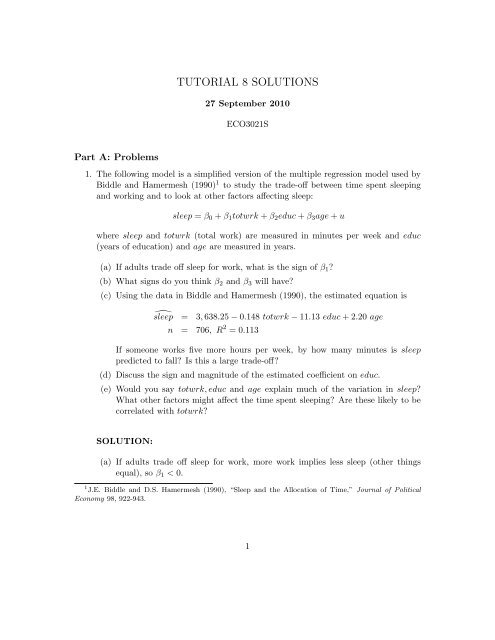Tutorial 8.pdf - Vula
Tutorial 8.pdf - Vula
Tutorial 8.pdf - Vula
- No tags were found...
You also want an ePaper? Increase the reach of your titles
YUMPU automatically turns print PDFs into web optimized ePapers that Google loves.
TUTORIAL 8 SOLUTIONS27 September 2010ECO3021SPart A: Problems1. The following model is a simplified version of the multiple regression model used byBiddle and Hamermesh (1990) 1 to study the trade-off between time spent sleepingand working and to look at other factors affecting sleep:sleep = β 0 + β 1 totwrk + β 2 educ + β 3 age + uwhere sleep and totwrk (total work) are measured in minutes per week and educ(years of education) and age are measured in years.(a) If adults trade off sleep for work, what is the sign of β 1 ?(b) What signs do you think β 2 and β 3 will have?(c) Using the data in Biddle and Hamermesh (1990), the estimated equation isŝleep = 3, 638.25 − 0.148 totwrk − 11.13 educ + 2.20 agen = 706, R 2 = 0.113If someone works five more hours per week, by how many minutes is sleeppredicted to fall? Is this a large trade-off?(d) Discuss the sign and magnitude of the estimated coefficient on educ.(e) Would you say totwrk, educ and age explain much of the variation in sleep?What other factors might affect the time spent sleeping? Are these likely to becorrelated with totwrk?SOLUTION:(a) If adults trade off sleep for work, more work implies less sleep (other thingsequal), so β 1 < 0.1 J.E. Biddle and D.S. Hamermesh (1990), “Sleep and the Allocation of Time,” Journal of PoliticalEconomy 98, 922-943.1
















